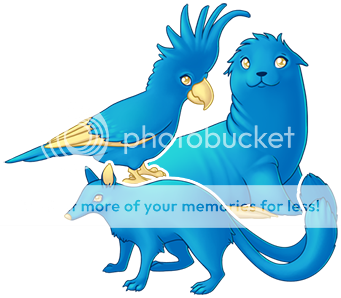|
|
|
|
|
|
|
|
|
 Posted: Wed Oct 30, 2013 4:51 pm Posted: Wed Oct 30, 2013 4:51 pm
|
|
|
|
|
|
|
|
|
|
 Posted: Wed Oct 30, 2013 4:52 pm Posted: Wed Oct 30, 2013 4:52 pm
APPEARANCE
Although giving the appearance of softness, Daiah fur is actually short and wiry. It is difficult for them to retain large amounts of body heat because of this. Their tails, in contrast, are quite long and covered in luscious, thick fur which can be wrapped around their bodies or used as a nest after they have had a litter. It has yet to be determined what the feathers are used for. However, it is quite certain that they serve a purpose and are of significance to the Daiah. It has also been noted that the colour of these feathers are the same as their eyes.
DIET
By nature, Daiah are vegetarians and largely subsist on fruits and vegetables. They will also eat leaves, flowers and grass that can be found.
MOVEMENT
Adult Daiah can travel at speeds slightly over 40 miles per hour.
|
 |
 |
|
|
|
|
|
|
|
|
|
|
|
|
|
|
|
 Posted: Wed Oct 30, 2013 4:55 pm Posted: Wed Oct 30, 2013 4:55 pm
APPEARANCE
Despite also having short fur like the Daiah, their coat is quite soft. Akala tails, notably longer by their bodies by half a length, assists in keeping themselves balanced when they are flying. Their huge ears makes their hearing quite acute, compensating for their mediocre eyesight and sense of smell.
DIET
Fussy eaters, Akala are only willing to eat fruits and berries. If they are unable to find any, they will simply starve.
MOVEMENT
Akala are considerably slower than all other Cluricaun due to their small size. They make up for this by the use of their wings. An adult Akala can make fly for up to 20 minutes before beginning to tire. Elders can fly for longer periods of time - up to an hour - as their wing span is much larger.
|
 |
 |
|
|
|
|
|
|
|
|
|
|
|
|
 Posted: Wed Oct 30, 2013 4:56 pm Posted: Wed Oct 30, 2013 4:56 pm
  APPEARANCE
Spending the entirety of their lives under water, both saltwater and fresh, the Gaya-dari have naturally adapted to this lifestyle. Their gills can be found on either side of their torso, halfway up their chests. They have scales which extend from the tips of their tails and end around where their gills are located. The remainder is covered in long fur. Although their eyesight is quite poor, Gaya-dari have an incredible sense of smell and are able to identify scents from several miles away.
Although Gaya-dari can surface above water, they have no internal apparatus with which to breathe air. As a result, coming up from the water for them is much like holding their breath although, if their gills remain beneath the water, they can manage for some amount of time above water.
DIET
Gaya-dari are omnivores and mainly eat small fish which they are quite adept at catching and supplement this with seaweed or other underwater plants.
MOVEMENT
With their powerful tails propelling them, Gaya-dari are able to swim through the water at almost 25 miles per hour, despite the drag offered by their fur.
|
 |
 |
|
|
|
|
|
|
|
|
|
|
|
|
|
|
|
 Posted: Wed Oct 30, 2013 4:58 pm Posted: Wed Oct 30, 2013 4:58 pm
  BONDING
A spiritual contract between Cluricaun and familiar. It is not necessary for a Cluricaun and familiar to bond - rather, a bond should only be pursued out of necessity or when a close friendship is already intact, and even then, only when both Cluricaun and familiar are in agreement. To enter into a bonding, the Cluricaun and familiar will extend their energies and meet in the dream world, where they will promise themselves to one another. Once bonded, the two are spiritually linked, and mentally connected - depending on the level of their relationship prior to bonding, the pair's connection ranges from sensing one another's emotions, to communicating telepathically. A bond can only be broken in death.
TWO-TAILED NUMBAT
Small creatures with long fur, a finely pointed muzzle, round-tipped ears and two bushy tails, which are roughly as long as the length of their bodies. They mainly inhabit forests and woodlands, but can also be found in grasslands. Due to the nature of their diet, numbats are active during the day, and retreat back to their nests at night. They find their food primarily using scent, but they also have a high visual perception.
Their diet consists strictly of termites, which they dig up with heavy claws and then eat with their long, sticky tongues.
An adult two-tailed numbat can travel up to 15 miles per hour.
COCKATOO
Smart and affectionate birds with large, curved beaks and tall crests of feathers on their heads. They tend to live in grassy savannas and open grasslands, taking up roost in trees, and living in flocks of varying size. Cockatoos are active during the day and rest at night, though they are not early risers, and will wait to venture from their roosts until well after the sun has risen.
They use their powerful beaks to crack open nuts and seeds, but will also eat fruit, and on occasion, insects.
In perfect conditions, adult cockatoos can fly up to 35 miles per hour.
FUR SEAL PUP
Aptly named for their thick coats, the fur seals have small external ears and long, muscular fore flippers. They have sharp eyesight, a keen sense of hearing, and when on land are able to walk on all fours. The fur seals spend the majority of their time in the water, able to do so because their fur coats keep them warm, even in freezing temperatures.
Fur seals mainly feed on fish, but are also known to hunt squid and eels.
The fur seals can swim up to 27 miles per hour, and are much slower on land.
|
 |
 |
|
|
|
|
|
|
|
|
|
|
|
|
 Posted: Wed Oct 30, 2013 5:00 pm Posted: Wed Oct 30, 2013 5:00 pm
|
|
|
|
|
|
|
|
|
|
|
|
|
 Posted: Wed Oct 30, 2013 5:01 pm Posted: Wed Oct 30, 2013 5:01 pm
|
|
|
|
|
|
|
|
|
|
 Posted: Wed Oct 30, 2013 5:02 pm Posted: Wed Oct 30, 2013 5:02 pm
|
|
|
|
|
|
|
|
|
|
|
|
|
 Posted: Wed Oct 30, 2013 5:05 pm Posted: Wed Oct 30, 2013 5:05 pm
|
|
|
|
|
|
 |
|
|
|
|
|
|


